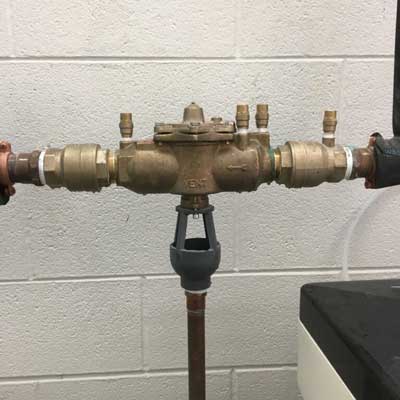RPZ Backflow Tests
A backflow valve needs regular testing, due to its component moving parts. The inlet, outlet and discharge valves are mechanical, so need to be tested periodically to avoid unexpected failures. An RPZ valve (high hazard rated) device, is typically tested after being installed due to a change of use in a building. Normally at one end there is an isolation valve, followed by a line strainer before water enters the valve to stop any impurities or grit from the water line entering the valve.
A backflow valve is usually located near the main water meter box, or on the supply side of the meter, which may be inside an irrigation box at ground level. The most common one is a double check back flow assembly, which is usually on the main line and on underground irrigation systems. If the backflow valve is not connected at the main line, it is most likely located where an irrigation system connects to the supply.
Above ground pressure vacuum breakers are testable assembly to prevent water flowing in the reverse direction and should be tested annually. A Watts backflow preventer can be installed with a one inch galvanized connector, screwing in a one inch right angled galvanized elbow onto the device. Two short (one foot) length of pipes are connected to the elbows to ensure the device is at least one foot above ground as per city requirements.
RPZ Valve Backflow Operation

A typical RPZ valve backflow protector is internally split into three different zones : an inlet zone, an outlet zone and a middle zone. A discharge valve is located in the middle zone and activated by pressure differences between inlet and outlet zones. Each zone is operated by a check valve which is operated only when the pressure difference between zones is correct.
In normal operation the pressure in the outlet zone will drop as water is used, the differential pressure between middle zone and outlet zone will rise, which will cause the outlet check valve to be opened. In addition the difference in pressure between inlet zone and the middle zone will rise which will cause the inlet check valve to open. This is known as flow operation. Both the inlet and outlet check valves will be open, and the discharge check valve will be closed.
If water consumption is stopped, the pressure on the outlet side will rise again. The difference in pressure between the outlet zone and the middle zone will drop, which will cause the outlet check valve to close. In this case the pressure difference between the inlet zone and the middle zone will drop, which will allow the inlet check valve to close. This is known as shut-off operation. In this situation the inlet pressure is higher than in the middle zone, and the middle zone pressure is higher than the outlet zone, so all three valves will be in the closed position.
If there is a failure in the main supply, the inlet zone pressure will fall relative to the middle zone. If the differential between inlet and middle zone is less than 150mbar differential, the outlet check valve will close and avoid the drainage of the system. The inlet check valve will close and the discharge valve will open. This functionality is what is so important to the public water supply, and is the main reason for regular backflow testing.
